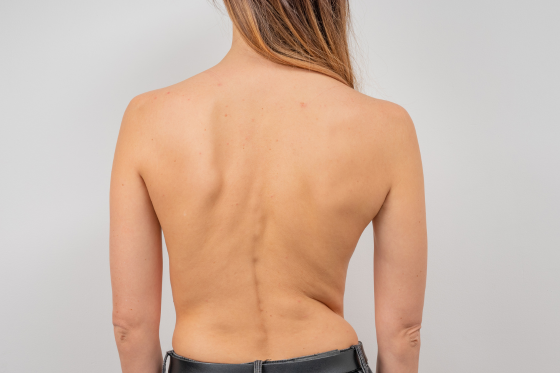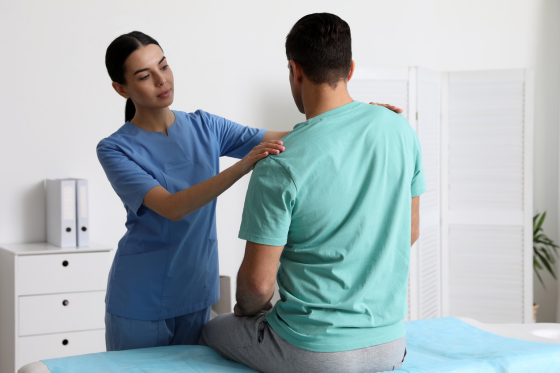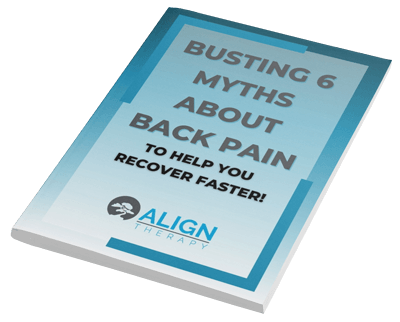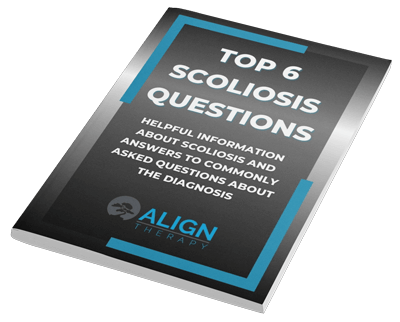I often think back to one patient, “Mark” (name changed for privacy), who came to me after 3 years of nearly complete inactivity. In his late 30s, he had gradually become more sedentary—sitting on the couch after work, avoiding sports and leisure activities because his back ached, declining to walk much beyond his immediate needs. Over time, his posture got much worse. He reported increasing back pain, stiffness, fatigue. Imaging revealed that his scoliosis curve had subtly progressed compared to scans from 3 years prior. The spine was losing support from the muscles that should be helping to stabilize it.
When Mark first walked into my clinic, his core and back muscles were significantly deconditioned. He struggled to hold a tall posture for even a few minutes. He couldn’t do simple activities like a full squat or holding a light weight overhead without discomfort. Because his muscles were weak and underused, his spinal deformity had less “backup”—the tissues that should protect and support the curve were nearly dormant.
We began a therapy plan centered on the Schroth method, because for someone with scoliosis, targeted corrective breathing, isometric holds, and sensorimotor retraining can help encourage more alignment and slow—or in some cases modestly reverse—curve progression. But Schroth alone was not enough. We also needed to rebuild his general strength and endurance so that his spine had a safety net of healthy musculature. Over months, Mark advanced from lying exercises to modified core work, to Schroth-inspired movement, to functional strength and eventually low-impact cardio.
By the time he left our care, Mark was walking 3–4 miles several times per week, doing strength routines, and noticing that his pain had reduced dramatically. His curve, meanwhile, had stabilized (no further worsening on follow-up). That turnaround was possible because we reactivated his body—and because he committed to being active.

Why Inactivity Hurts More Than You Think
If you or someone you know lives with scoliosis or another spinal deformity, you may have heard the advice: “Don’t overdo it. Don’t stress the spine. Don’t do impact activities.” While there’s truth in avoiding harmful overloads, there’s a far greater risk in doing too little.
Here’s what prolonged inactivity can do:
- Muscle atrophy and weakness. The muscles that help support and control the spine—deep core stabilizers, spinal erectors, paraspinals, hip stabilizers—need regular use to function well. When disregarded, they shrink, atrophy, become less coordinated, and lose their capacity to respond to load or stress.
- Loss of proprioception and motor control. The nervous system becomes less efficient at sensing spinal position and less capable of fine-tuned corrective adjustments.
- Less structural “backup” to resist curve progression. In scoliosis, the spine is under asymmetric loading. If the muscles that should help “push back” against that tendency are weak, the passive structures (ligaments, discs, bones) bear more stress. Over years, that can contribute to gradual worsening.
- Stiffness, pain, and compensation. The inactive spine becomes stiffer. To move, people develop compensatory patterns, which often lead to chronic discomfort, joint strain, or overuse injuries in other areas (hips, knees, shoulders).
- Reduced cardiovascular fitness and endurance. Even everyday tasks—walking, standing, doing chores—become fatiguing, reinforcing the sedentary loop.
- Psychological toll. Extended inactivity or “hiding inside the house” can feed depression, anxiety, social isolation, and a low mood. It becomes a negative spiral: less activity, more pain, more fear, more withdrawal.
In short: you can’t strengthen what you rarely use. If your spinal muscles are operating at near-baseline levels of function, they simply can’t help you resist compressive forces.
Activity Is Not Optional: It’s Essential
Here’s why being active matters when you have scoliosis or another spinal deformity:
- It preserves or improves muscle support around the spine. Every step, every breath, every small movement recruits stabilizers. The more you move (within safe bounds), the stronger and more responsive those muscles become.
- It enhances circulation and tissue health. Good blood flow delivers nutrients, removes waste, and helps maintain disc and ligament health. Movement prevents stagnation.
- It encourages better neuromuscular control. Practicing movement—especially with precision—helps your brain, spinal cord, and muscles talk more effectively. That means better posture, balance adjustments, and less “collapsing” into the deformed pattern.
- It helps resist curve progression. A more active spine with properly toned musculature acts as a buffer to the asymmetric forces pushing the curve.
- It builds endurance and resilience for daily life. When your back is stronger, day-to-day tasks—picking up kids, gardening, lifting grocery bags—become less painful and less risky.
- It improves your mental and emotional outlook. Movement releases endorphins, reduces stress, boosts mood, and helps break the cycle of fear, isolation, and “waiting to get worse.”
Choosing Activities You’ll Stick With
One of the biggest stumbling blocks I see: someone with scoliosis wants to be active, but they don’t have any hobbies or interests outside of sedentary routines (TV, reading, social media). If the activity isn’t enjoyable, it won’t last. Here’s how I guide patients to find their path:
- Start small and exploratory. Try walking in a nearby park, gentle swimming, low-impact cycling, or a beginner’s Pilates or yoga (preferably with someone who knows the scoliosis spine). This is not about immediate intensity—it’s about rediscovering movement.
- Make it something you like. If you enjoy swimming, that’s great. If you hate swimming but love dancing or hiking, lean into that. The best exercise is the one you’ll come back to.
- Social or family-based options. Walks with a friend, a family hike, bike rides with kids—these mix movement with connection.
- Vary and cross-train. Don’t lock into a single kind of movement from day one. Mix in strength, mobility, balance, cardiovascular activity.
- Set a realistic schedule. Aim for small wins: a 10-minute walk after dinner, a 5-minute core warm-up in the morning, or a short movement break between chores.
- Track progress and celebrate wins. Logging steps, recording feeling scales (pain, energy, mood) or photos of posture can help you see change over weeks and months.
When you enjoy the activity, you’re far more likely to persevere, which is exactly what your spine needs.
A Balanced Program: Schroth + Strength + Endurance
From my experience, the most effective long-term approach for someone with scoliosis or spinal deformity is layered:
- Schroth-based corrective work. This includes specialized breathing techniques, isometric or conscious postural holds, and sensorimotor relearning focused on the unique 3D aspects of your curve pattern. This is your “precision tool” for influencing alignment and motor control.
- Foundation strengthening. Work on core, glutes, hips, back, and stabilizers with progressively challenging but safe exercises (e.g. abdominal bracing, planks, rows).
- Endurance and movement training. Walking, cycling, swimming, elliptical work, or light jogging build stamina for everyday life.
- Flexibility and mobility. Gentle stretching, joint mobility drills, foam rolling—especially for hips, hamstrings, and the thoracic spine—help reduce compensation tension.
- Integration into daily habits. Over time, your posture and movement patterns outside therapy sessions become part of your normal functioning—no need to “think” about everything.
Over time, these layers compliment each other and mesh. The magnitudes of improvement might be small week to week, but they are cumulative. That is how you reduce pain, slow or halt curve progression, increase confidence, and reclaim function.

The Mental Reset: Movement Heals More Than the Spine
It’s not just your back that benefits from movement—it’s your mind, your spirit, your outlook. Sitting inside day after day fosters gloom, anxiety, rumination. Movement offers:
- A sense of agency and progress when you feel your strength return and your stamina climb.
- Stress relief. Physical activity helps regulate cortisol, relieve tension, and counter mental fatigue.
- Distraction and perspective. Instead of looping fears about “what if my curve worsens,” you get out in the world, breathe fresh air, connect with nature, or socialize.
- Community. Joining walking groups, classes, or outdoor meetups connects you to others who value movement.
- Momentum. When you feel better physically, you’re more willing to try more, to push just a little further, to re-engage with life rather than retreat.
Don’t Wait for a “Crisis” — Start Now
If you recognize yourself in Mark’s story—or even just a little bit—know this: you don’t need to wait until your pain becomes unbearable or your curve becomes glaringly worse to get started. The sooner you ignite movement, the more protective you make your spine.
If you’d like help adapting safe, corrective, and enjoyable activity for your spine—especially in the setting of scoliosis or other spinal deformity—I’d love to help you. You don’t have to navigate this alone.
Free Consultation Offer:
You’re welcome to come in for a Free Consultation, where we’ll:
- Assess your spine, posture, and curve pattern
- Evaluate your current strength, mobility, endurance, and movement habits
- Discuss what activities you love or might enjoy
- Build a customized, realistic plan combining Schroth-based corrective work plus general exercise and lifestyle strategies
- Answer your questions and give you a clear first-step plan
If you’re ready to stop letting your spine hold you back—and instead empower yourself with movement and control—click here [Schedule Your Free Consultation] or call us at (801)980-0860.
You deserve to move without fear, to strengthen your body, to slow curve progression, to reclaim confidence in your spine—and to rediscover joy in movement. Let’s take that first step together.
David Butler, Physical Therapist



